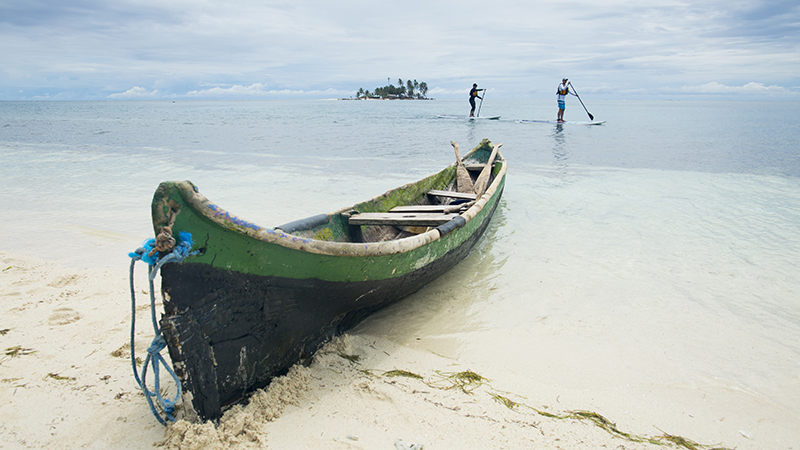The week before I sail, I hear from a buddy who had gone on a similar trip. “Pack a clothesline,” she says, “you’re gonna need it.” I have one coming from Amazon in a matter of seconds.
On board, the first thing I hang on it are dozens of wet American dollars, soaking from being left in the pocket of my swim trunks. Seriously, the humidity in this part of the world is beyond stifling, even for those who live with it regularly. Thankfully, I adjust quickly (and so will you), but my cotton stuff never recovers nor does my canvas backpack, despite being thrown in the ship’s kitchen freezer overnight to try to kill the bacteria. Thank god for quick-drying fabrics. Live and learn.
Deep in the Rainforest
Further down the Pacific coast from my boobies, we stop in at an Indigenous village in the Darién province, where we spend the afternoon communing with a tribe of very welcoming Emberá villagers still living the same traditional jungle life that goes back centuries.
As we disembark from motorized dugout canoes, a huge crowd meets us, clapping and singing to drum and pipe accompaniment. After taking in the blaze of colour of the traditional outfits—and the lack of clothing, too—I notice the ubiquitous dark blue tattoos sported by everyone, including the children. They turn out to be drawn with vegetable dye, which contains an ingredient that works as an insect repellent.
While some set up craft tables with beaded pendants, woven baskets, carved wooden dishware and the like, others give us tastes of raw sugar cane and show us how they mill grain by hand. After a formal welcome, a bit of ceremonial dancing and a brief rain shower—this is the rainforest after all—I join one of the villagers giving on a tour.
The place is desperately poor. These people are clinging to their original way of life, but it in no way looks easy. The ramshackle buildings all on stilts, the mud, the communal gardens, the wash house, and a single satellite phone booth all point to a harder way of life than I will ever witness again. A simple stockade sits ready to shame wrong-doers. Despite the insufficiencies, the villagers are all very proud of it all, committed to the community and their past—and to teaching visitors all about it. A few guests from the ship brave the tattoo lady’s chair to get some freehand embellishment, once we hear the dye only lasts about three weeks.
The other cool thing about this area is the mangroves, a region of tropical coastal vegetation comprising salt-tolerant trees and shrubs stretching through the shallow sub-tidal zones. Existing before humans, these magical little plants are their own beautiful ecosystem, filtering the salt out of their roots. Kayaking through the mangroves yields an exquisite sense of peace and an arresting realization that I’m visiting a place few people ever get the chance to visit.
I team up in a tandem kayak with a gentleman of about 70 who paddles faster than I can and doesn’t once run out of steam, despite my thinking he would any second. In fact, I have to ask him to slow down. There are no shrinking violets on this voyage and no one has to be told twice to start lining up for the lifejackets. I can tell that the younger passengers are in awe of some of the older ones who have ten tons of gumption. Being adventurous isn’t something you grow out of, I guess.
“The older generation was happy to look, to stand out on the bow and see a whale or a glacier or a bear,” says Dan. “The boomers and GenXers aren’t satisfied with just seeing. They need to touch it and experience things in a meaningful way.”
My takeaway in this regard is that I’m going the adventure route while I’m still fit enough to kayak, paddleboard, snorkel for more than an hour, hop in and out of handmade wooden canoes in the jungle and then drink beer all night.
We slow our kayaks down quite a bit to squeeze as much out of the mangrove experience as possible. Even my paddle mate eases off on the full steam ahead. We languish in the approaching sunset, drinking in the silence, watching the pelicans dive-bomb for fish in the estuary. No wonder these poor creatures go blind from this daily grind. We can see our ship, but aren’t obliged to hurry up, thankfully. This crew is very adept at modifying plans on the fly.
“Our built-in flexibility is great,” says Dan, “but it frustrates our chef sometimes when we call and say, ‘You know, the conditions are perfect and people are loving this kayak. Let’s stretch it a couple of hours.’”




